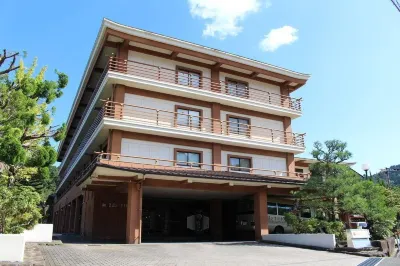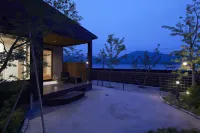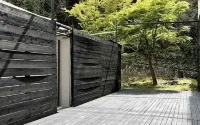
Odkryj pobyt w mieście Hatsukaichi
Wprowadź daty podróży, aby sprawdzić aktualne ceny i dostępność
Przesuń w górę, aby zobaczyć więcej
Filtruj według:
Liczba gwiazdek hotelu
≤2345
Popularne filtry
Niesamowity 4,5+Świetny 4,0+Dobry 3,5+Przyjemny 3,0+Znaleźliśmy dla Ciebie hotele (52) w mieście Hatsukaichi
Wybierz daty podróży, aby zobaczyć aktualne ceny.
Najpopularniejsze
Najniższa cena
Blisko centrum
Najwyżej oceniane



Hotel w pobliżu: Itsukushima Island,Hatsukaichi 100% gości wybiera ten rejon
2023.06.03
Sakuraya in Miyajima is a remarkable ryokan that truly captures the essence of Japanese hospitality. The highlight of my stay was the spacious Japanese-style room with a mesmerizing sea view. The traditional decor and ambiance added to the authentic experience, making me feel like I had stepped back in time. The location was superb, allowing easy access to Miyajima's attractions. The clean and well-maintained room provided a sense of tranquility and comfort. The simple yet delicious $5 breakfast consisting of bread, butter, jam, egg, fruits, and fresh juice was a delightful way to start each day. While the basement onsen had a slightly eerie atmosphere, it was immaculately clean, and the rejuvenating experience made it worthwhile. Overall, Sakuraya offers a memorable ryokan experience, combining cultural immersion, comfort, and a touch of adventure
Excellent
Oceny: 67
4.5/5
Cena od
€ 74
za noc



Hotel w pobliżu: Itsukushima Island,Hatsukaichi 100% gości wybiera ten rejon
EEmily_peal 2019.07.01
The location of the hotel is very good, very close to the Yanshima Shrine, the Millennium Pavilion, and the Five-Pagoda. It didn't take a few steps. After we arrived at the ferry terminal, we met the hotel's shuttle bus and checked the baggage back. Then we strolled along the coast easily and went back to the hotel with our Yanshima Shrine. In the evening, come out to see the big bird house floating on the water after the high tide. The hotel is built on the mountain and the entrance is relatively small. We confirmed at the door that the hotel should belong to a larger hotel in Yandao. Although it is a bit old, the room is very large, with tatami and western style, very comfortable. The hot springs are well-regulated. It is said to be effective for arthritis. It doesn't feel embarrassing for a day. It is a hotel dinner. It is a good dinner for a hotel that has stayed at no more than 20 hot spring hotels. , recommended.
Excellent
Oceny: 32
4.5/5
Cena od
€ 784
za noc



Hotel w pobliżu: Itsukushima Island,Hatsukaichi 100% gości wybiera ten rejon
施施 2019.02.01
This is definitely the best service hotel in Japan. Everyone knows that Japan's service attitude has always been good. This is a bit of a good time. As long as you see the waiter, you will smile and say hello! You can try it for dinner, and the meal is very rich! The hot springs in the hotel are not a bit boring in the open air, but the bubbles are not bad. There are a bunch of deer at the door~... You can call the hotel at the Miyajima Pier. If you want to go to the shrine, you can call the hotel to send you. Room we are on the fourth floor, sea view is OK!
Excellent
Oceny: 59
4.5/5
Cena od
€ 219
za noc

Możesz preferować
Hotele ze śniadaniemHotele z pokojem z 2 łóżkami 1-osobowymiHotele z 1 podwójnym łóżkiemHotele z basenemHotele z bezpłatnym anulowaniem



Hotel w pobliżu: Itsukushima Island,Hatsukaichi 100% gości wybiera ten rejon
RRosemarie Wu 2018.12.24
The location is very good, just a few minutes walk to the Itsukushima Shinto Shrine and Mt. Misen Ropeway station. There is a free shuttle bus station right outside the hotel to go the ropeway station. You can see the Torii throughout the hotel window. At night when the Torii with lights on, the view is stunning! The indoor onsen is not big but it's ok for 10+ people at the same time, the outside onsen is small and can only occupies 4-5ppl.
The staff in the hotel are very friendly and thoughtful. I was fully wet after the hiking to Mt. Mismen on the raining day, they helped me to dry all my shoes and coat. Happy to stay at Iwaso and will definitely stay again.
Excellent
Oceny: 47
4.5/5
Cena od
€ 310
za noc



Hotel w pobliżu: Hatsukaichi
Located in Hatsukaichi, OUCHI HOTEL Hatsukaichi-ekimae is within a 15-minute drive of Setonaikai National Park and Hiroshima Green Arena. This apartment is 6.4 mi (10.3 km) from Itsukushima Shrine and 11.7 mi (18.9 km) from Mazda Zoom-Zoom Stadium.
Featured amenities include express check-out and laundry facilities.
Make yourself at home in one of the 8 guestrooms, featuring kitchenettes. Rooms have private balconies. 40-inch flat-screen televisions with digital programming provide entertainment, while complimentary wireless internet access keeps you connected. Private bathrooms with separate bathtubs and showers feature deep soaking bathtubs and complimentary toiletries.
Oceny: 5
3.9/5
Cena od
€ 42
za noc



Hotel w pobliżu: Hatsukaichi
Kkanchiezou 2021.07.31
I decided by looking at the photo of the open-air bath. The moment I went, I thought it was a little old, but it happened to be changed to a high-ranked room, and it was spacious and great. It was a room with 2 rooms, so I could sleep 2 people each by 4 people. It was large enough to sit at the table even if I laid a futon. I feel that there were two faucets in the washroom. There are also 2 toilets. It was nice to have something! Thank you very much. It's a full-fledged open-air, but it's really round. (If you stand up), but I want you to keep this spectacular view without blindfolding in the future! !! !! I just have to stand up! !! !! Really superb view. wonderful. I wanted to take a picture, but it was raining and I couldn't. I can't shoot normally. .. .. No, it's okay. The open-air bath here. You should take it. I climb the stairs outside from the usual bath, but what is it? I was surprised to think. It's the best. Rice, I love , so it's the best when served. Isn't it enough for people who like it? The pot of the pot. Also, whether it was breakfast or dinner, the rice was cooked in 々. (I'm sorry. I'm ambiguous because I stayed overnight, but I think it was a hotel here.) I felt that the rice grains were also delicious. The bath in the photo is another bath. But the best thing is the Marumie open air that I couldn't take. Overall, I think it was very good.
Very Good
Oceny: 5
4.2/5
Cena od
€ 185
za noc



Hotel w pobliżu: Itsukushima Island,Hatsukaichi 100% gości wybiera ten rejon
Featuring air-conditioned accommodation with a balcony, Villa Hamorebi is situated in Miyajima. This property offers access to a terrace, free private parking and free WiFi. Guests have access to a hot tub and open-air bath. Boasting a Blu-ray player, the holiday home has a fully equipped kitchenette with a fridge and a minibar, a living room with a seating area and a dining area, 1 bedroom, and 2 bathrooms with a bidet and a bath. Guests at this holiday home are welcome to enjoy wine or champagne and fruits. Additional in-room amenities include chocolates or cookies. A bar can be found on-site. Guests can also relax in the garden or in the shared lounge area. Popular points of interest near the holiday home include Itsukushima Shrine, Daisho-in Temple and Five Storey Pagoda. The nearest airport is Iwakuni Kintaikyo Airport, 29 km from Villa Hamorebi.
Outstanding
4.6/5
Cena od
€ 372
za noc



Hotel w pobliżu: Hatsukaichi
Miyahama Onsen is the closest onsen village to Miyajima Island
Excellent
Oceny: 3
4.5/5
Cena od
€ 402
za noc



Hotel w pobliżu: Itsukushima Island,Hatsukaichi 100% gości wybiera ten rejon
すすん 2022.04.03
It was great. It is a guest house in Miyajima. We stayed with 3 people. It was about 25000 yen a night.
The room is very large !! I thought it was in a house. There was also a veranda in the room on the first floor. It is with kitchen ♪ There is also a counter seat, and it is not troublesome for a place to eat and drink.
The location is in front of Miyajima ferry terminal.
Outstanding
Oceny: 6
4.8/5
Cena od
€ 60
za noc



Hotel w pobliżu: Hatsukaichi
GGuest User 2023.05.29
I used it for the first time this time.
Sakashima Shrine, Pinghe Park
The hotel also wrote that it was not so painful that I was worried about the sound of the denshi by word of mouth
My friends were happy to have this comfortable hotel for the first time
It was more than the price
I would like to use it if I have another chance.
Very Good
Oceny: 16
4.1/5
Cena od
€ 140
za noc
Najczęściej wybierane hotele w: Hatsukaichi, które są uwielbiane przez podróżników
Zobacz wszystkie
Wybierz jeden z najczęściej rezerwowanych hoteli w zeszłym miesiącu
No.1
4.6/5
125 ocenaGrandvrio Hotel Miyajima Wakura - Route Inn Hotels -
Hotele w: Hatsukaichi
"Great stay!""Delicious breakfast"
Wybierz daty, aby zobaczyć cenyNo.2
3.9/5
56 ocenaLiVEMAX RESORT AKI MIYAJIMA
Hotele w: Itsukushima Island, Hatsukaichi 100% gości wybiera ten rejon
"Great stay!""Friendly owner"
Wybierz daty, aby zobaczyć cenyNo.3
4.4/5
128 ocenaMiyajima Coral Hotel
Hotele w: Hatsukaichi
"Great location""Great rooms"
Wybierz daty, aby zobaczyć cenyNo.4
4.6/5
51 ocenaHotel Miyajima Villa
Hotele w: Itsukushima Island, Hatsukaichi 100% gości wybiera ten rejon
"Good Location"
Wybierz daty, aby zobaczyć cenyNo.5
4.6/5
26 ocenaItsukushima Iroha
Hotele w: Itsukushima Island, Hatsukaichi 100% gości wybiera ten rejon
"Good Location"
Wybierz daty, aby zobaczyć cenyNo.6
3.9/5
69 ocenaAki Grand Hotel & Spa
Hotele w: Hatsukaichi
"Good Location"
Wybierz daty, aby zobaczyć cenyNo.7
3.5/5
1 ocenaGlobal Resort Misen
Hotele w: Hatsukaichi
"Good Location"
Wybierz daty, aby zobaczyć cenyNo.8
3.5/5
4 ocenaGlobal Resort Ono de Lune
Hotele w: Hatsukaichi
"Good Location"
Wybierz daty, aby zobaczyć cenyNo.9
4.5/5
20 ocenaKikunoya
Hotele w: Itsukushima Island, Hatsukaichi 100% gości wybiera ten rejon
"Great stay!"
Wybierz daty, aby zobaczyć cenyNo.10
4.4/5
43 ocenaMiyajima Hotel Makoto
Hotele w: Itsukushima Island, Hatsukaichi 100% gości wybiera ten rejon
"Good Location"
Wybierz daty, aby zobaczyć cenyObudź się na pyszne śniadanie w: Hatsukaichi
Zobacz wszystkie
Zacznij dzień od smacznego śniadania w jednym z naszych ulubionych hoteli w tym mieście
LiVEMAX RESORT MIYAHAMA ONSEN OCEAN
Hotele w: Hatsukaichi
Located in Hatsukaichi, Livemax Resort Miyahama Onsen-ocean is a 3-minute walk from Miyahama Hot Spring and 11 minutes by foot from Setonaikai National Park. This spa hotel is 5.9 mi (9.5 km) from Miyajima Ferry Terminal and 6.4 mi (10.3 km) from Five-Story Pagoda.
Pamper yourself with a visit to the spa, which offers massages. You can take advantage of recreational amenities such as hot springs, a spa tub, and a sauna. This hotel also features complimentary wireless internet access, a television in a common area, and a vending machine.
Enjoy a meal at the restaurant, or stay in and take advantage of the hotel's room service (during limited hours). Relax with your favorite drink at the bar/lounge or the poolside bar. Buffet breakfasts are available daily for a fee.
Featured amenities include a safe deposit box at the front desk, an elevator, and coffee/tea in a common area. Free self parking is available onsite.
Treat yourself to a stay in one of the 20 guestrooms, featuring outdoor private spa tubs and flat-screen televisions. Your pillowtop bed comes with down comforters and premium bedding. Complimentary wireless internet access keeps you connected, and digital programming is available for your entertainment. Conveniences include safes and desks, and housekeeping is provided daily.
4.0/5
Very Good23 ocenaCena za noc od:€ 139
Kinsuikan
Hotele w: Itsukushima Island, Hatsukaichi 100% gości wybiera ten rejon
With a stay at Miyajima Kinsuikan in Hatsukaichi (Itsukushima), you'll be steps from Setonaikai National Park and 5 minutes by foot from Itsukushima Shrine. This spa ryokan is 0.4 mi (0.6 km) from Miyajima Ferry Terminal and 15.8 mi (25.4 km) from Hiroshima Green Arena.
Take time to pamper yourself with a visit to the full-service spa. Additional amenities at this ryokan include complimentary wireless internet access, gift shops/newsstands, and a ballroom.
Enjoy a satisfying meal at Mametanuki serving guests of Miyajima Kinsuikan. Wrap up your day with a drink at the bar/lounge.
Featured amenities include complimentary newspapers in the lobby, luggage storage, and a library. Free self parking is available onsite.
Make yourself at home in one of the 39 air-conditioned rooms featuring refrigerators and flat-screen televisions. Complimentary wireless internet access is available to keep you connected. Bathrooms have complimentary toiletries and bidets. Conveniences include safes and desks, and housekeeping is provided daily.
4.6/5
Outstanding37 ocenaCena za noc od:€ 351
Jukeiso
Hotele w: Itsukushima Island, Hatsukaichi 100% gości wybiera ten rejon
With a stay at Jukeiso in Hatsukaichi (Itsukushima), you'll be steps from Setonaikai National Park and 4 minutes by foot from Itsukushima Shrine. This ryokan is 16 mi (25.8 km) from Hiroshima Green Arena and 17.3 mi (27.8 km) from Mazda Zoom-Zoom Stadium.
This smoke-free ryokan offers wheelchair access.
Free self parking is available onsite.
Make yourself at home in one of the 13 guestrooms featuring minibars and flat-screen televisions. Complimentary wireless internet access is available to keep you connected. Bathrooms feature shower/tub combinations, complimentary toiletries, and hair dryers. Conveniences include electric kettles and free tea bags/instant coffee, and housekeeping is provided daily.
4.6/5
Outstanding47 ocenaCena za noc od:€ 182
Hotel Miya Rikyu
Hotele w: Itsukushima Island, Hatsukaichi 100% gości wybiera ten rejon
2.5 km from Tsutsumigaura Beach in Miyajima, Hotel Miya Rikyu features accommodation with access to a sauna, spa facilities and public bath. Featuring sea and mountain views, this ryokan also offers free WiFi. The accommodation provides a 24-hour front desk, a lift and luggage storage for guests. All units in the ryokan are fitted with a kettle. Complete with a private bathroom equipped with a bidet and slippers, the units at the ryokan have a flat-screen TV and air conditioning, and certain rooms include a balcony. At the ryokan, every unit has bed linen and towels. Continental and Asian breakfast options with warm dishes, local specialities and fruits are available daily at the ryokan. There is a coffee shop on-site. Guests at Hotel Miya Rikyu will be able to enjoy activities in and around Miyajima, like hiking. Popular points of interest near the accommodation include Five Storey Pagoda, Itsukushima Shrine and Daisho-in Temple. Iwakuni Kintaikyo Airport is 28 km away.
4.6/5
Outstanding10 ocenaCena za noc od:€ 229
Global Resort Miyajima View
Hotele w: Hatsukaichi
Global Resort Miyajima View Hiroshima provides flawless service and all the necessary facilities for visitors. Visitors can take advantage of complimentary parking directly at the resort. Should you prefer not to venture out for a meal, the enticing culinary choices at resort are always available for your satisfaction. Throughout the day and evening, grab a bite to eat from resort's self-service vending machines whenever you please.
3.3/5
2 ocenaCena za noc od:€ 32
Miyajima Morinoyado
Hotele w: Itsukushima Island, Hatsukaichi 100% gości wybiera ten rejon
With a stay at Miyajima MorinoYado Inn in Hatsukaichi (Itsukushima), you'll be steps from Setonaikai National Park and 6 minutes by foot from Miyajima Aquarium. This hotel is 0.3 mi (0.4 km) from Itsukushima Shrine Treasure Hall and 0.4 mi (0.6 km) from Itsukushima Shrine.
Make use of convenient amenities such as complimentary wireless internet access, gift shops/newsstands, and a banquet hall.
At Miyajima MorinoYado Inn, enjoy a satisfying meal at the restaurant. Full breakfasts are available daily from 7:00 AM to 9:00 AM for a fee.
Featured amenities include luggage storage, a safe deposit box at the front desk, and an elevator. This hotel has 2 meeting rooms available for events.
Make yourself at home in one of the 30 air-conditioned rooms featuring refrigerators and flat-screen televisions. Complimentary wireless internet access is available to keep you connected. Bathrooms have bidets and hair dryers. Conveniences include safes and electric kettles, and housekeeping is provided daily.
4.1/5
Very Good41 ocenaCena za noc od:€ 74
LiVEMAX RESORT AKI MIYAHAMA ONSEN
Hotele w: Hatsukaichi
Located in Hatsukaichi, LiVEMAX RESORT Aki Miyahama-Onsen is in the historical district, a 3-minute walk from Miyahama Hot Spring and 11 minutes by foot from Setonaikai National Park. This hotel is 5.9 mi (9.5 km) from Miyajima Ferry Terminal and 6.4 mi (10.3 km) from Five-Story Pagoda.
Enjoy recreational amenities such as hot springs and a seasonal outdoor pool. Additional amenities at this hotel include complimentary wireless internet access, barbecue grills, and a vending machine.
Enjoy a meal at the restaurant, or stay in and take advantage of the hotel's room service (during limited hours).
Featured amenities include complimentary wired internet access, a 24-hour front desk, and luggage storage. Free self parking is available onsite.
Treat yourself to a stay in one of the 12 individually decorated guestrooms, featuring private plunge pools and outdoor private spa tubs. Your pillowtop bed comes with down comforters and premium bedding. Complimentary wired and wireless internet access keeps you connected, and cable programming provides entertainment. Conveniences include safes and refrigerators, and housekeeping is provided daily.
4.2/5
Very Good1 ocenaCena za noc od:€ 137
Yamaichi Bekkan
Hotele w: Itsukushima Island, Hatsukaichi 100% gości wybiera ten rejon
With a stay at Yamaichi Bekkan in Hatsukaichi (Itsukushima), you'll be steps from Setonaikai National Park and 5 minutes by foot from Miyajima Ferry Terminal. This guesthouse is 0.5 mi (0.8 km) from Itsukushima Shrine and 15 mi (24.2 km) from Hiroshima Green Arena.
At Yamaichi Bekkan, enjoy a satisfying meal at the restaurant.
The front desk is staffed during limited hours. Free self parking is available onsite.
Make yourself at home in one of the 5 air-conditioned rooms featuring LCD televisions. Complimentary wireless internet access keeps you connected, and digital programming is available for your entertainment. Private bathrooms with shower/tub combinations feature hair dryers and slippers. Conveniences include electric kettles, and housekeeping is provided daily.
4.7/5
Outstanding12 ocenaCena za noc od:€ 173
Omotenashi Hostel Miyajima
Hotele w: Hatsukaichi
With a stay at OMOTENASHI Hostel Miyajima in Hatsukaichi, you'll be 4.6 mi (7.3 km) from Itsukushima Shrine and 11.7 mi (18.8 km) from Hiroshima Museum of Art. This hostel is 12.1 mi (19.5 km) from Hiroshima Castle and 12.2 mi (19.6 km) from Hiroshima City Museum of Contemporary Art.
Enjoy recreational amenities such as karaoke and bicycles to rent. Additional features at this hostel include complimentary wireless internet access, concierge services, and shopping on site.
Grab a bite from the snack bar/deli serving guests of OMOTENASHI Hostel Miyajima. Japanese breakfasts are available daily from 7:00 AM to 10:00 AM for a fee.
Featured amenities include a 24-hour front desk, multilingual staff, and luggage storage. Self parking (subject to charges) is available onsite.
Make yourself at home in one of the 24 air-conditioned rooms featuring flat-screen televisions. Complimentary wireless internet access keeps you connected, and digital programming is available for your entertainment. Bathrooms have showers and hair dryers. Housekeeping is provided daily, and extra futon mattress (complimentary) can be requested.
4.2/5
Very Good17 ocenaCena za noc od:€ 21
Zobacz, jak inni podróżnicy ocenili hotele w: Hatsukaichi
Zobacz wszystkie
Przeglądaj autentyczne oceny i opinie prawdziwych podróżników, które pomogą Ci znaleźć idealne zakwaterowanie
5.0/5
Perfect
GGuest UserIncredible traditional Japanese house, newly renovated with everything you need for comfort. The kitchen is extremely well-stocked for us to prepare our own meals. The garden is beautiful and you can enjoy ocean view and sunrise from the house, there’s even a blooming Cherry Blossom tree in the garden. Just a tip to keep the sliding doors closed properly because mosquitoes do get in. Couldn’t have asked for a better stay.
4.7/5
Outstanding
Really nice traditional guesthouse to stay in Miyajima. Right in the heart of the old town and couple of minutes walk from the shrine. The chef is an absolute sushi master also and was amazed by the sushi omakase tasting menu we received as part of our stay. It included some different fish i was hoping to try while in Japan. Would definitely recommend staying overnight if you get the chance if visiting Miyajima as the shrine and Tori gate is really nice lit up at night when quieter with less tourists and the Shiomachi-An guesthouse made for a really nice place to stay
Miyajima Machiya Hotel Shiomachi-An
Hotele w: Itsukushima Island, Hatsukaichi 100% gości wybiera ten rejon
Cena za noc od:€ 213
2.9/5
旅旅遊N次過客Good location, very close to the station and the pier, there are staff at check in, the staff is also very friendly and willing to help, the bed in the room is clean, the fork plug is not enough, Pantry is narrow and a bit messy, and the price is low.
Jak podróżni oceniają atrakcje w: Hatsukaichi
Odkryj te miejsca, które warto odwiedzić w mieście Hatsukaichi i wybierz pobliski hotel dla większej wygody
Miyajima
游游侠半仙World Heritage Miyajima
In December 1996, the World Heritage Committee officially registered Itsukushima Shrine as a World Heritage Site. The registered area includes Itsukushima Shrine, the sea in front and the Misen Primeval Forest (natural monument) in the back, totaling 431.3 hectares, accounting for about 14% of the total area of Miyajima.
Three Views of Japan - Miyajima in Aki
In 1643, Confucian scholar Lin Chunzhai traveled across Japan on foot and wrote "A Study of Japanese National Deeds" based on his travel experiences. In the article, Matsushima, Amanohashidate and Itsukushima (Miyajima) were named "Three Wonders (i.e. the best scenic spots)".
Itsukushima Jinja
游游侠半仙The Japanese Miyashima Yamashima Shrine sacrifices Shimaji, Shimaji Tainhime and Shizuki, who are revered as the goddess of the three goddesses. They are worshipped as patrons of the sea, maritime security, transportation and wishing achievements. The shrine is famous for its unique architectural beauty and the art of palace-style architecture is inspiring. It was built in 593 and was converted from the then Quangui Pingqingsheng in 1168 and preserved to this day. The unique configuration in the Turkic Sea and the contrast with the beautiful mountains behind, all reflect the ambition and power of Qing Shenggong. The center of the "This Society" (Main Hall) is equipped with several shrines, which also have a stage, music hall, hall and so on. The buildings are connected by a 300m-long corridor. The bright red color of the shrine and the big bird house is said to eliminate evil and demons. The building is also coated with anti-corrosion Zhu paint.
Itsukushima Jinja Otorii (Grand Torii Gate)
游游侠半仙The Miyajima Torii in Japan is the Torii of Itsukushima Shrine. It is a national important cultural property. It is about 16.6m high and weighs about 60 tons. The cypress roof is 24.2m long. The main column has a circumference of 9.9m and is made of natural nanmu. The current Torii was rebuilt in 1875, and it is the eighth generation since the Heian period. The upper beam is hollow, and it is filled with fist-sized stones totaling 7 tons, so it can stand in the ocean current without falling.
Momijidani Park
翱翱翔的大鲨鱼Red Leaf Valley Park, autumn is full of red leaves, especially beautiful when the sun shines at noon. There is also a beautiful maple leaf forest behind Mishan Bentang, but unfortunately I can't go in. The ginkgo in front of Qiandige is also golden yellow, and you can directly hit this big ginkgo from many places on the island. The maple leaves in the Grand Holy Court have fallen, but the surrounding ginkgo and maple leaves are still in the wind. Unfortunately, there is no sunlight when I go in the afternoon, and the photos are darker.
Mount Misen
游游侠半仙Mount Miyajima, Japan, is covered with dense green virgin forests and is 535 meters above sea level. It is the highest mountain in Miyajima and has been revered as a sacred mountain since ancient times. There is a temple near the top of the mountain that is related to the famous founder of the Shingon sect, Kobo Daishi. There are strange rocks everywhere and an observation deck. There is a ropeway connecting the Lion Rock Station of Mount Miyajima and the Red Leaf Valley Park.
Daishoin
一一只流浪的小野喵The oldest temple in Miyajima, Daishoin, has a long history of more than 1,200 years. When going to Miyajima, be sure not to miss the Daisho-in Temple behind Itsukushima Shrine. It is also a place where various gods gather.
✨The Daisho-in is located in Miyajima Town, Hatsukaichi City, Hiroshima Prefecture. It is also called Takiyama Daisho-in Suijingji Temple. It is the oldest temple in Miyajima. Daisho-in is one of the most important temples of the Shingon sect. Daishoin is located on the mountainside of Mishan. Mishan was the founder of the Shingon sect, Kobo Daishi, who began his practice on Miyajima. The Great Holy Temple has several buildings, sculptures and other religious objects for visitors to enjoy.
✨These buildings include Kannon Hall, Mani Hall, Manpuku Hall, Aizen Meiou Hall, and Ichiwan Daishi Hall. A sand altar made by a monk from Tibet, a tea room and a monsho cave, which houses the main statues of 88 temples across Japan. There are also many Buddha statues placed in the temple such as the eleven-faced Avalokitesvara Bodhisattva, the main deity of the Kyodo Hall, Hakiri Fudo Myooh, the Three Demons Daigongen, and the Seven Gods of Good Luck. Many of them were donated by believers.
✨In the temple, along the stone steps, there are a large number of stone Arhats, covered with moss, of various shapes, full of warmth, and almost every Buddha statue wears a woolen hat hand-knitted by believers on its head, which is very lively and cute.
Five-Story Pagoda
游游侠半仙The Miyajima Five-Tower is said to have been created in 1407 and is 28m high, cleverly blending Japanese and Chinese architectural skills with Tang Dynasty architecture. The interior walls are painted with colorful Buddha statues.
Itsukushima Jinja Senjokaku Pavilion
游游侠半仙Senjokaku (Toyokuni Shrine) in Miyajima, Japan
Toyokuni Shrine, widely known as "Senjokaku", is a sutra hall built by Toyotomi Hideyoshi to honor the war victims. It was originally built in the "Irimoya style", but Toyotomi Hideyoshi died before it was completed, so it has not been completed until now.
Hatsukaichi – Często zadawane pytania
Które hotele w: Hatsukaichi są popularne?
Hatsukaichi oferuje wiele popularnych hoteli. Zarówno podróżujący służbowo, jak i prywatnie chętnie wybierają Grandvrio Hotel Miyajima Wakura - Route Inn Hotels -, LiVEMAX RESORT AKI MIYAJIMA i Miyajima Coral Hotel.
Ile wynosi średnia cena noclegu w: Hatsukaichi?
Średnia cena hoteli w: Hatsukaichi w dni powszednie wynosi € 303, a w weekendy (piątek-sobota) € 329.
Które luksusowe hotele są polecane w: Hatsukaichi?
Hatsukaichi oferuje wiele luksusowych hoteli o różnych stylach. Itsukushima Iroha jest popularnym wyborem.
Które hotele w: Hatsukaichi oferują wysokiej jakości śniadania?
Itsukushima Iroha,LiVEMAX RESORT AKI MIYAJIMA i Aki Grand Hotel & Spa oferują znakomite śniadanie. Zacznij dzień od pysznego śniadania!
Które hotele w: Hatsukaichi zapewniają zaplecze fitness?
Grandvrio Hotel Miyajima Wakura - Route Inn Hotels -, LiVEMAX RESORT AKI MIYAJIMA i Aki Grand Hotel & Spa oferują zaplecze fitness. Nie musisz rezygnować z treningów nawet podczas podróży!
Które hotele w: Hatsukaichi akceptują zwierzęta?
Miyajima Shiro akceptuje zwierzęta. Zabierz ukochanego zwierzaka w podróż!
Które hotele w: Hatsukaichi oferują basen?
Grandvrio Hotel Miyajima Wakura - Route Inn Hotels -, LiVEMAX RESORT AKI MIYAJIMA i Itsukushima Iroha oferują basen. Zatrzymaj się w jednym z tych hoteli, aby korzystać z basenu!
Które hotele w: Hatsukaichi zapewniają bezpłatne Wi-Fi?
Niezależnie od tego, czy podróżujesz służbowo, czy prywatnie, szybki internet jest niezbędny w podróży. Grandvrio Hotel Miyajima Wakura - Route Inn Hotels -, LiVEMAX RESORT AKI MIYAJIMA i Miyajima Coral Hotel to popularne hotele z bezpłatnym Wi-Fi.
Które hotele w: Hatsukaichi oferują gorące źródła?
Chcesz skorzystać z gorących źródeł w swoim hotelu? Grandvrio Hotel Miyajima Wakura - Route Inn Hotels -, Hotel Miyajima Villa i Miyahama Grand Hotel oferują gorące źródła. Zarezerwuj już teraz!
Które hotele w: Hatsukaichi oferują transfery lotniskowe?
Pierwszy raz odwiedzasz: Hatsukaichi? Grandvrio Hotel Miyajima Wakura - Route Inn Hotels -, LiVEMAX RESORT AKI MIYAJIMA i Miyajima Coral Hotel oferują transfery lotniskowe.
Które hotele w: Hatsukaichi oferują wysoko oceniane SPA?
Doskwiera Ci zmęczenie w podróży? Grandvrio Hotel Miyajima Wakura - Route Inn Hotels -, LiVEMAX RESORT AKI MIYAJIMA i Hotel Miyajima Villa oferują wysokiej jakości SPA.
Jakie promocje hotelowe są dostępne w: Hatsukaichi?
Trip.com oferuje różne promocje i rabaty dla użytkowników przez cały rok. Sprawdź aktualne oferty na stronie promocji w serwisie Trip.com.
Lokalne informacje dla podróżnych
| Najwyższa cena | € 1 925 |
|---|---|
| Najniższa cena | € 33 |
| Liczba opinii | 1,111 |
| Liczba hoteli | 143 |
| Średnia cena (dni powszednie) | € 303 |
| Średnia cena (weekend) | € 329 |